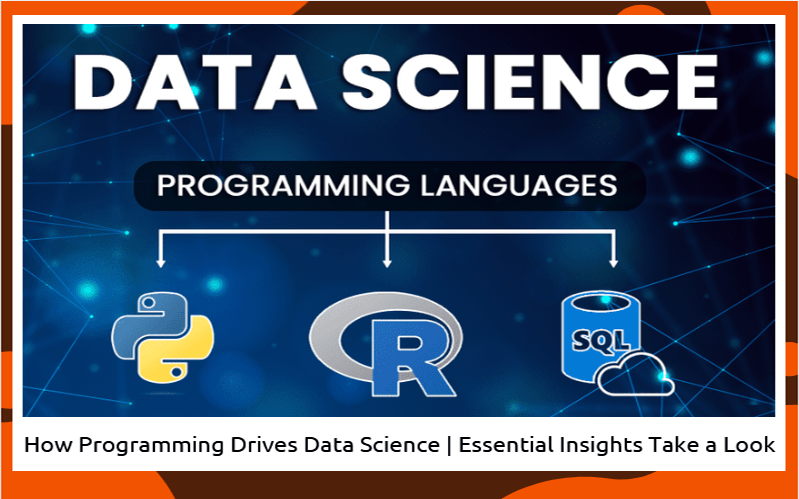Let’s face it — data doesn’t talk on its own. It needs a voice. And that voice is programming. In the world of data science, programming is the secret ingredient that turns raw numbers into meaningful insights.
Without it, data would just sit there — silent, messy, and useless. Think about it. Every chart, every prediction, every trend analysis — they all begin with a few lines of code.
Whether it’s Python, mostly used in AI & Machine learning, R, or SQL, programming gives data scientists the power to clean, analyze, and visualize information with precision and creativity.
But that’s not all. Programming also builds the bridge between human logic and machine intelligence. It helps us train models, automate tasks, and make smarter decisions faster than ever.
From detecting fraud to predicting diseases, from optimizing marketing campaigns to improving customer experience — programming powers it all.
In this article, we’ll explore how programming truly powers data science, the key skills you need, and why every data-driven professional must master the art of coding.
So, sit back, imagine your data as a story waiting to be told — and let’s see how programming helps you write that story beautifully.
Why Programming is the Heart of Data Science
Here’s the truth — data science can’t breathe without programming. It’s like the heartbeat that keeps the entire system alive.
No matter how powerful your data tools are, they all rely on one thing — code.
Programming gives data scientists the control they need. It allows them to clean messy data, remove duplicates, handle missing values, and prepare datasets for real analysis.
Without programming, all of that would take hours — maybe days. With it, it takes minutes.
Take Python for example. It’s not just popular — it’s practical. With libraries like Pandas, NumPy, and Matplotlib, data scientists can explore millions of data points in seconds.
And when it comes to advanced modeling? Machine learning frameworks like TensorFlow and Scikit-learn do the magic — all powered by code.
But programming isn’t just about speed. It’s about flexibility and creativity. You can automate repetitive tasks, test hypotheses, or even build predictive models that learn on their own.
That’s how programming powers data science — it transforms human curiosity into machine intelligence.
So, if data science is the brain, programming is definitely the heart that keeps it beating strong.
Key Programming Languages Every Data Scientist Should Know
Every data scientist needs the right tools — and those tools come in the form of programming languages.
Each one plays a special role in shaping how data is collected, processed, and visualized.
From the flexibility of Python to the precision of R, the reliability of SQL, and the growing power of Julia — these languages form the backbone of modern data science.
They make it easier to clean data, run analytics, and build predictive models that actually work.
If you’d like to dive deeper into which languages are trending right now — and why they matter for your data journey — check out this detailed guide:
👉 Top Trending Programming Languages – W3Speech
These languages prove one thing again and again — how programming powers data science by turning logic, creativity, and data into real-world intelligence.
Real-World Examples | How Programming Transforms Data into Insights
Programming doesn’t just crunch numbers — it solves real problems. Let’s see how.
💳 Fraud Detection in Banking
Python scripts analyze thousands of transactions every second. They identify suspicious patterns and stop fraud before it happens. That’s how programming powers data science — keeping digital banking safe.
🏥 Predicting Diseases in Healthcare
Machine learning models built with Python and R predict diseases early. They learn from patient data and help doctors take timely action. In this way, programming turns raw data into life-saving insights.
🛒 Personalized Recommendations in E-Commerce
Smart recommendation engines use code to study your behavior. They predict what you might want next — making shopping smarter and faster.
🌦️ Weather Forecasting and Climate Research
Through complex simulations written in Python and Julia, scientists can predict climate changes and help communities prepare better.
FAQ – How Programming Powers Data Science
So far, we’ve learned a lot about how programming powers data science. Now, let’s explore some important questions and answers to clear your doubts.
Yes, but it’s tough. Tools exist, but coding gives full control and flexibility. Learning Python or R is highly recommended.
It depends on your effort. With consistent practice, 3-6 months can give a solid foundation. Real mastery comes with projects.
Basic math and statistics are enough to start. Advanced math helps in deep learning or AI, but not required initially.
Python is the easiest and most versatile choice. Later, you can explore R, SQL, or Julia based on your goals.
Not entirely. Programming is essential, but data analysis, statistics, and domain knowledge are equally important for a full data scientist profile.
Final Thoughts | The Future of Programming in Data Science
The journey of data science is just getting started. And guess what? Programming will always be at the center of it.
With Artificial Intelligence, Machine Learning, and Big Data growing every day, the demand for skilled programmers is rising fast.
Curious about how to become a programmer? New tools and frameworks may come, but the foundation remains the same — code. Because no matter how advanced technology becomes, it still needs human logic to guide it.
In the near future, we’ll see programming blend even more deeply with automation and AI.
Imagine writing code that teaches itself to improve — that’s not a dream anymore, it’s happening right now.
This is exactly how programming powers data science to reach new heights of innovation and efficiency.
So, if you’re thinking about your next skill, start here — learn to code. Because every data story, every business insight, and every AI breakthrough begins with one simple thing: a few lines of programming.

